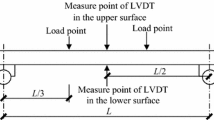Abstract
In analysing wood creep during moisture changes, various adjustments can be made to the data, including corrections for density and for dimensional changes. Provided that the variation of elastic compliance with moisture content is known, the elastic compliance can be separated from the total compliance to give a “reduced” creep compliance. Elastic compliance data can be formed into a graphical chart based on moisture content and the compliance at a single known moisture content. Good correlations have been obtained between reduced creep compliances for various modes of moisture change and the unloaded axial movement coefficientsβ L. Ifβ L could be considered as a measure of a number of internal “events”, related to hydrogen bonding, and taking place during moisture changes; then the number of these events might also be related to moisture-induced creep changes.
Similar content being viewed by others
Abbreviations
- J :
-
compliance
- J E :
-
elastic compliance
- J R :
-
reduced compliance
- J 0 :
-
elastic compliance of wood at 7% moisture content
- dJ ++/du :
-
rate of change of compliance with moisture during humidification through moisture levels reached for the first time, after loading at low moisture content
- dJ −−/du :
-
rate of change of compliance with moisture during dehumidification through moisture levels reached for the first time, after loading at high moisture content
- dJ +/du :
-
rate of change of compliance with moisture during humidification at levels already previously reached since loading
- dJ −/du :
-
rate of change of compliance with moisture during dehumidification at levels already previously reached since loading
- u :
-
moisture content
- β T :
-
unloaded movement coefficient in the tangential direction
- βL:
-
unloaded movement coefficient in the longitudinal direction
- θ :
-
mean microfibril angle of the S2 layer of the cell wall
References
D. Hunt,J. Mater. Sci. 19 (1984) 1456.
L. Armstrong andR. Kingston,Aust. J. Appl. Sci. 13 (1962) 257.
A. Schniewind,Holz Roh u. Werkstoff 24 (1966) 87.
P. Grossman,Wood Sci. Technol. 10 (1976) 163.
J. Launay, M. Mudry andF. Gilletta, in Proceedings of the Congres de Rheologie, Paris (1984).
H. Carrington,Aeron. J. 26 (1922) 462.
T. Wilson, US Department of Agriculture Bulletin 282, Washington, USA (1932).
F. Kollman andH. Krech,Holz Roh u. Werkstoff 18 (1960) 41.
D. Hunt,J. Mater. Sci. 21 (1986) 2088.
A. Ranta Maunus,Wood Sci. Technol. 9 (1975) 189.
D. Hunt andM. Darlington,Polymer 19 (1978) 977.
I. Cave,Wood Sci. Technol. 12 (1978) 127.
D. Cowdrey andR. Preston,Proc. R. Soc. Lond. 166B (1966) 245.
Author information
Authors and Affiliations
Rights and permissions
About this article
Cite this article
Hunt, D.G., Shelton, C.F. Progress in the analysis of creep in wood during concurrent moisture changes. J Mater Sci 22, 313–320 (1987). https://doi.org/10.1007/BF01160586
Received:
Accepted:
Issue Date:
DOI: https://doi.org/10.1007/BF01160586




